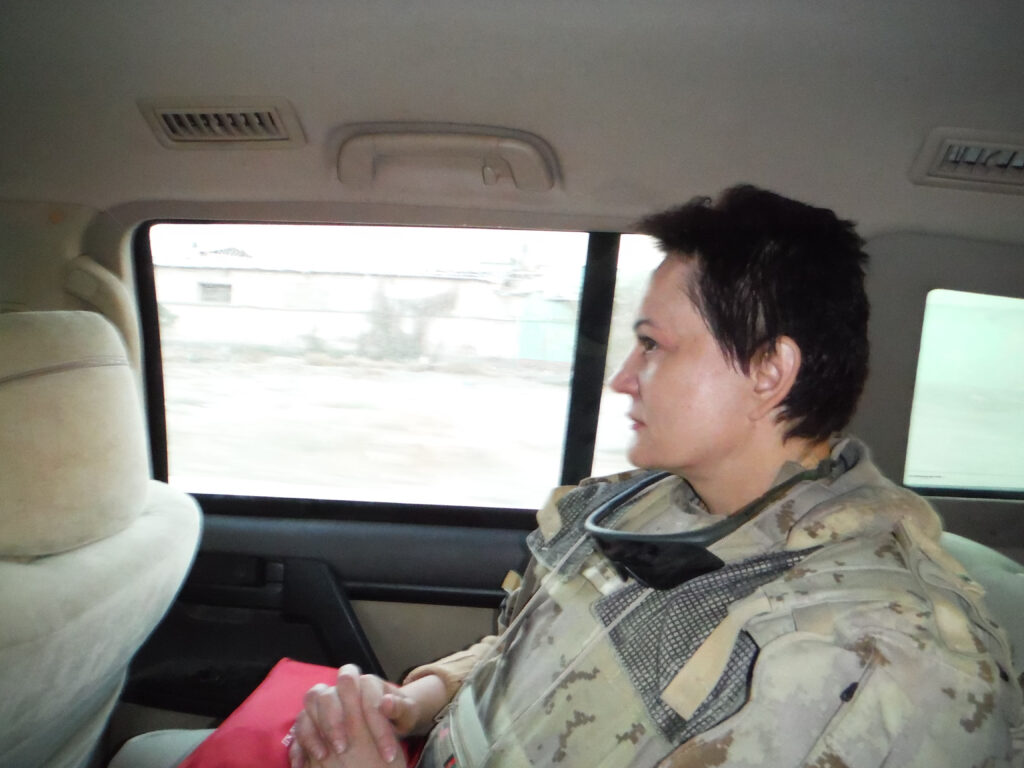The clinical and experimental research of Dr. Ibolja Cernak focuses on pathophysiology and rehabilitation. With her focus on long-term neurological, behavioural and multi-organ functional deficits, she works for the advancement of clinical knowledge on blast-induced injuries in military and veteran populations. With 35+ years of clinical and experimental experience, she is an expert in medicine, biomedical engineering and public health preparedness, physiology, neuroscience, and clinical pathophysiology.
Physiology is the “queen” of medicine. When you understand physiology, you understand the pathophysiology and, therefore, the basics of clinical medicine. Otherwise, you don’t see the big picture. When residents of different specialities don’t understand complex cases, they often ask clinical pathophysiologists for help. Seeing the complexity and the big picture was the biggest throw for me!
Dr. Ibolja Cernak
The Beginning
Before beginning medical education, Dr. Cernak was a student of Natural Sciences. During her vacations, she visited the neuropsychiatry department of a regional hospital. That department truly fascinated her and she decided to enrol as an elective student. The head of the department and in-charge inquired whether she was a nursing student or a medical technician. Surprisingly, she was neither. Instead, she was a student of Natural Sciences! Luckily, the authority was intrigued and accepted her.
The Neuropsychiatry department provided me with hands-on experience. That experience directed me to medicine. I chose medicine over beautiful astronomy and music – my other utmost favourites. This is how I started medicine!
Dr. Ibolja Cernak

Pathophysiology & Neuroscience
In 1984, Dr. Ibolja Cernak completed her medical education at the University of Belgrade, Serbia. Subsequently, parallel with her work at the Military Medical Academy as a researcher, she started her Master in Science studies in biomedical engineering. Later, in 1988, she completed her engineering education. In 1989, she completed her residency in pathophysiology at Military Medical Academy, Belgrade. In 1990, she obtained a PhD in neuroscience. Later, in 2010, she earned a Master of Science degree in Homeland Security in Public Health Preparedness at the Pennsylvania State University. Her academic record has been remarkable!
The phenomenal educational record explains her extraordinary accomplishments. Her career began as a professor at Military Medical Academy, Belgrade. From 2001 to 2005, she worked as a research associate professor at the Department of Neuroscience, Georgetown University Medical Centre. Between 2006-2012 she was a Medical Director and Principal Professional Staff (Full-professor equivalent) at the Johns Hopkins University Applied Physics Laboratory. She served as Professor and Chair at Military & Veterans Clinical Rehabilitation Research, University of Alberta from 2012 to 2018. Currently, she is a professor of pathophysiology and neuroscience at Mercer University School of Medicine, Georgia, USA.
My job is still my passion! Your passion keeps you honest. When you lose the passion you lose the impulse that pushes you ahead with curiosity and purpose. The purpose is to continue progress. You wake up in the morning thinking ‘Another day for moving ahead!’.
Dr. Ibolja Cernak
Into the Battlefield of Kosovo
During her residency at Military Medical Academy, Dr. Ibolja Cernak received clinical and experimental experience. Soon after she started her work, the war in former Yugoslavia also started. At that time, she had already commenced her research about blast injuries. Being involved in this research and having injured soldiers admitted at the Military Medical Academy for treatment reinforced her research focus. Then, an idea struck her.
‘What if I am at the spot where and when soldiers are injured by a blast? Let’s go and see the circumstances of the injury and understand better.’ Soon, I ended up on the battlefield of Kosovo!
Dr. Ibolja Cernak

The idea of practically experiencing the circumstances of blasts in the war gave her exclusive insight into the situation. She learnt about the first phase of immediate response to injury. Before this step, injured soldiers sought medical help only when there were visible injuries with clearly manifesting symptoms. Also, often, the earliest possible access to hospitals for those exposed to the blast was over five hours from the site of injury.
I collected samples to look at neuroendocrine changes, signs of endothelial injury and oxidative stress, as well as biomarkers of injury severity and outcome. The samples were taken as early as zero to five minutes after injury. This quick approach was possible only because I was right there (or close) where the soldiers had been injured.
Dr. Ibolja Cernak
Dr. Cernak returned to Belgrade. She continued her assessments and tested the samples in the laboratory. These assessments specifically involved soldiers, who were there when the blasts happened but didn’t seem to have any visible injuries.
Imagine: 20-plus years old, physically healthy soldiers struggling with memory! They coped with everyday life using post-it notes spread around themselves. Young individuals, leave messages such as “I had breakfast”, and remove the note after having breakfast and prepare a new one “Prepare lunch”. With immense trust, soldiers would say ‘I know that I am screwed, but you will fix me, won’t you?”. That trust was and still is the push for me to keep going ahead with my research. Gaining clear insight into what is happening in the brain of these young soldiers I wanted to learn how to help them.
Dr. Ibolja Cernak
Visibly, nothing was wrong with the soldiers. However, signs of neurological and behavioural impairments usually begin appearing after months and even years of the blast. Consequently, Dr. Cernak’s research insisted on brain injury after blasts.
Dr. Ibolja Cernak continued her research on the effects of chronic military stress on the body’s ability to respond to injuries, including blast injury. In 2013, she conducted research in Afghanistan, embedded with the Canadian Armed Forces.
Dr. Cernak’s Research: Blast-induced Neurotrauma
Blast injuries are complex injuries even when someone does not have dramatic signs of external trauma. Soldiers and others exposed to bomb blasts may present with pathologies several years later. Usually, they present with short-term memory impairments, impaired EEG, sluggish reflexes and other neurological deficits. The previous dogma that the blast-generated pressure can’t directly damage the brain argued that the brain is protected by the most perfect helmet in the world – the skull. Dr. Cernak’s research, based on her observation, challenged this dogma emphasising the unique response of the brain to explosion-generated blast. However, it was not easy.
During my first attendance at an international conference, I presented my clinical data about the neurological consequences of blast exposure in soldiers without visible injuries. Suddenly, I was interrupted by a person who asked me to stop reporting such nonsensical data. I was shocked! Indeed, the beginning was not so smooth.
Dr. Ibolja Cernak

Blast exposure is common in military service. Military and law-enforcement personnel, repeatedly exposed to low-level blasts, can have significant changes in the brain – including subtle disruption or impairments of signal processing and inflammation; the development of these changes is more probable if the exposures are repeated. A blast wave is generated by an explosion, resulting in a sudden increase in air pressure that is followed by negative pressure, or suction by the blast wave. Military Breachers and Range Staff (MBRS) are routinely exposed to repetitive low-level blasts of 2–3 psi (14-21 kPa) during training and deployment. Larger blast exposures in the range of 60–80 psi (550 kPa) can be lethal.
While the entire body (especially organs containing different tissue densities such as lungs, bowel, and ear, among others) is susceptible to blast injury, the brain seems particularly vulnerable. Repetitive low-level blasts, while unlikely to cause mechanical trauma via acceleration and/or rotation of the head, nevertheless can result in neuropsychological and neurocognitive deficits and generally decreased physical and mental health.
Breacher’s syndrome is one example of blast-induced neurotrauma. Breachers are soldiers, who are using explosives to breach certain barriers. The pathological changes caused by blast exposures seem to be synergistic; hence, blast injuries can be accumulating. Consequently, even low-level blast exposures when repeated several times can cause injury. The blast-induced changes often start manifesting with functional impairments; thus, their diagnosis using imaging methods is challenging. The underlying causes for these functional impairments are at cellular, molecular, and even ultra-structural levels: loss of mitochondria’s ability to generate energy, metabolic impairments, and damage to the endothelial linings of the blood vessels, among many others. Importantly, it seems that some brain structures are more sensitive to blast than others: among them, the brainstem, cerebellum and prefrontal cortex.
Dr. Ibolja Cernak
In 2014, the U.S. National Academies Institute of Medicine published a report on the long-term effects of blast exposure. The report outlined the most frequent health impairments due to blasts and recommended that those should be classified as military service injuries when operational information about blast exposure exists.
The Revolution Ahead
Dr. Ibolja Cernak is confident about young doctors revolutionising the future of medicine. She encourages medical students to be always open-minded. An open-minded attitude leverages the influx of ideas that seem impossible and improbable now but could definitely be revolutionary. It is these ‘crazy’ ideas that open new doors to achievements and make the leaps of progress happen.
You should never hesitate to try new ideas only because others are not doing it.
Dr. Ibolja Cernak
Thanks to Dr. Ibolja Cernak for her fierce dedication towards her ideas: because of them, some people, particularly soldiers, might have a life with lesser health challenges.




